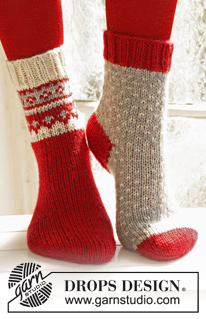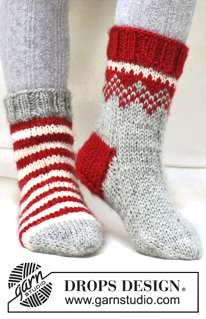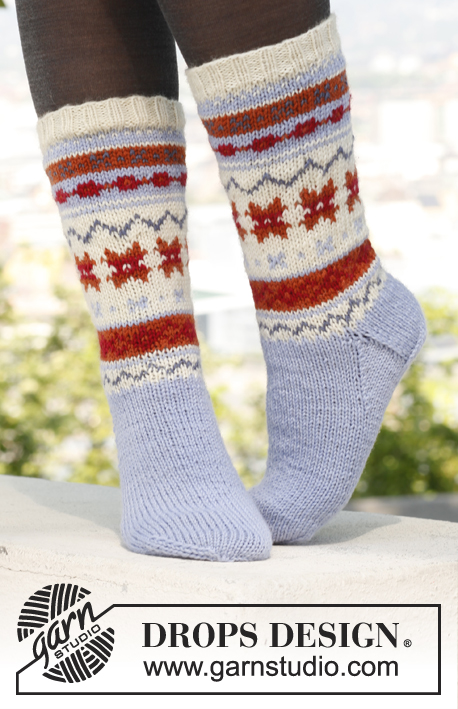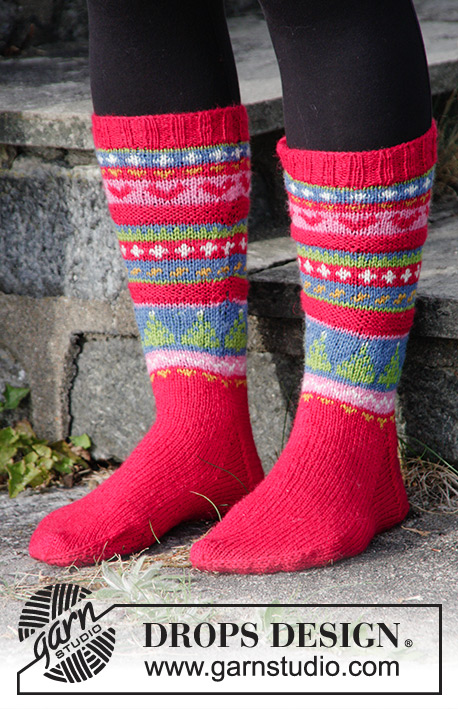Twinkle Toes |
||||||||||
 |
 |
|||||||||
Knitted socks for baby, children and adults in DROPS Karisma. Piece is worked with Nordic pattern. Size 22 - 43. Theme: Christmas
DROPS Extra 0-865 |
||||||||||
|
PATTERN: See diagrams A-1 to A-4. Work entire pattern in stocking st. DECREASE TIP: Dec as follows before marker: K 2 tog. Dec as follows after marker: Slip 1 st as if to K, K 1, psso. HEEL DECREASE: Row 1 (= RS): Work until (6-6-6-7-7) 8-9-9 sts remain, slip 1 st as if to K, K 1, psso, turn piece. Row 2 (= WS): Work until (6-6-6-7-7) 8-9-9 sts remain, slip 1 st as if to P, P 1, psso, turn piece. Row 3 (= RS): Work until (5-5-5-6-6) 7-8-8 sts remain, slip 1 st as if to K, K 1, psso, turn piece. Row 4 (= WS): Work until (5-5-5-6-6) 7-8-8 sts remain, slip 1 st as if to P, P 1, psso, turn piece. Continue dec like this with 1 st less before every dec until (8-10-10-10-10) 10-10-12 sts remain on needle. -------------------------------------------------------- SOCK 1 (grey with dots): Worked in the round on double pointed needles. Cast on (40-44-44-48-48) 52-56-60 sts on double pointed needles size 3.5 mm with wine red. K 1 round, continue in rib = P 2/K 2. Work rib for (3-3-3-3-3) 4-4-4 cm, then switch to light grey and K 1 round while dec 4 sts evenly = (36-40-40-44-44) 48-52-56 sts. Then work diagram A-1. When piece measures 11-11-12-12-13 (14-15-15) cm, keep the first (18-20-20-22-22) 24-26-28 sts on needle for heel, and slip the remaining (18-20-20-22-22) 24-26-28 sts on a stitch holder (= mid on top of foot). Work in stocking st back and forth on heel sts with wine red for (4-4½-4½-5-5) 5-5½-6 cm. Insert a marker. Then work HEEL DECREASE - see explanation above! After heel decrease, knit up (9-9-10-10-10) 10-11-11 sts on each side of heel with light grey and slip the (18-20-20-22-22) 24-26-28 sts from the stitch holder back on needle = (44-48-50-52-52) 54-58-62 sts. Continue to work in stocking st in the round and diagram A-1 - AT THE SAME TIME dec in each side as follows: K tog the first 2 sts after the (18-20-20-22-22) 24-26-28 sts on upper foot and K twisted tog the last 2 sts before the (18-20-20-22-22) 24-26-28 sts on upper foot (i.e. work in back loop of sts instead of front). Repeat dec every other round 3 more times = (36-40-42-44-44) 46-50-54 sts. Continue until piece measures (10-11-13-14-16) 18-20-22 cm from marker on heel (= approx. (3-4-4-4-4) 4-4-5 cm remain). Now insert a marker in each side so that there are (18-20-21-22-22) 23-25-27 sts both on top of foot and under foot. Continue in stocking st with wine red - AT THE SAME TIME dec 1 st on each side of both markers for toe - READ DECREASE TIP: Repeat dec every other round (2-3-3-2-2) 3-3-4 more times and then every round a total of (2-2-2-4-4) 5-6-6 times = (16-16-18-16-16) 10-10-10 sts remain on needle. On next round K all sts tog 2 by 2. Cut the thread and pull it through the remaining sts, tighten tog and fasten. SOCK 2 (wine red and off white stripes): Worked in the round on double pointed needles. Cast on (40-44-44-48-48) 52-56-60 sts on double pointed needles size 3.5 mm with light grey. K 1 round, continue in rib = P 2/K 2. Work rib for (3-3-3-3-3) 4-4-4 cm, then K 1 round while dec 4 sts evenly = (36-40-40-44-44) 48-52-56 sts. Continue with diagram A-2. When piece measures 11-11-12-12-13 (14-15-15) cm (stop after 3 rounds with wine red), keep the first (18-20-20-22-22) 24-26-28 sts on needle for heel, and slip the remaining (18-20-20-22-22) 24-26-28 sts on a stitch holder (= mid on top of foot). Work in stocking st back and forth over heel sts with light grey for (4-4½-4½-5-5) 5-5½-6 cm. Insert a marker. Then work HEEL DECREASE - see explanation above! After heel decrease, knit up (9-9-10-10-10) 10-11-11 sts with off white on each side of heel and slip the (18-20-20-22-22) 24-26-28 sts from the stitch holder back on needle = (44-48-50-52-52) 54-58-62 sts. Continue to work in stocking st in the round and diagram A-2 - AT THE SAME TIME dec in each side as follows: K tog the first 2 sts after the (18-20-20-22-22) 24-26-28 sts on upper foot and K twisted tog the last 2 sts before the (18-20-20-22-22) 24-26-28 sts on upper foot (i.e. work in back loop of sts instead of front). Repeat dec every other round 3 more times = (36-40-42-44-44) 46-50-54 sts. Continue until piece measures (10-11-13-14-16) 18-20-22 cm from marker on heel (= approx. (3-4-4-4-4) 4-4-5 cm remain). Now insert a marker in each side so that there are (18-20-21-22-22) 23-25-27 sts both on top of foot and under foot. Continue in stocking st with light grey - AT THE SAME TIME dec 1 st on each side of both markers for toe - READ DECREASE TIP: Repeat dec every other round (2-3-3-2-2) 3-3-4 more times and then every round a total of (2-2-2-4-4) 5-6-6 times = (16-16-18-16-16) 10-10-10 sts remain on needle. On next round K all sts tog 2 by 2. Cut the thread and pull it through the remaining sts, tighten tog and fasten. SOCK 3 (wine red with pattern on the leg): Worked in the round on double pointed needles. Cast on (40-44-44-48-48) 52-56-60 sts on double pointed needles size 3.5 mm with off white. K 1 round, continue in rib = P 2/K 2. Work rib for (3-3-3-3-3) 4-4-4 cm, then K 1 round while dec 4 sts evenly = (36-40-40-44-44) 48-52-56 sts. Continue with diagram A-3. When A-3 has been worked, finish the sock in wine red. When piece measures 11-11-12-12-13 (14-15-15) cm, keep the first (18-20-20-22-22) 24-26-28 sts on needle for heel, and slip the remaining (18-20-20-22-22) 24-26-28 sts on a stitch holder (= mid on top of foot). Work in stocking st back and forth on heel sts for (4-4½-4½-5-5) 5-5½-6 cm. Insert a marker. Then work HEEL DECREASE - see explanation above! After heel decrease, knit up (9-9-10-10-10) 10-11-11 sts on each side of heel and slip the (18-20-20-22-22) 24-26-28 sts from the stitch holder back on needle = (44-48-50-52-52) 54-58-62 sts. Continue to work in stocking st in the round while AT THE SAME TIME dec in each side as follows: K tog the first 2 sts after the (18-20-20-22-22) 24-26-28 sts on upper foot and K twisted tog the last 2 sts before the (18-20-20-22-22) 24-26-28 sts on upper foot (i.e. work in back loop of sts instead of front). Repeat dec every other round 3 more times = (36-40-42-44-44) 46-50-54 sts. Continue until piece measures (10-11-13-14-16) 18-20-22 cm from marker on heel (= approx. (3-4-4-4-4) 4-4-5 cm remain). Now insert a marker in each side so that there are (18-20-21-22-22) 23-25-27 sts both on top of foot and under foot. Continue in stocking st - AT THE SAME TIME dec 1 st on each side of both markers for toe - READ DECREASE TIP: Repeat dec every other round (2-3-3-2-2) 3-3-4 more times and then every round a total of (2-2-2-4-4) 5-6-6 times = (16-16-18-16-16) 10-10-10 sts remain on needle. On next round K all sts tog 2 by 2. Cut the thread and pull it through the remaining sts, tighten tog and fasten. SOCK 4 (grey with pattern on the leg): Worked in the round on double pointed needles. Cast on (40-44-44-48-48) 52-56-60 sts on double pointed needles size 3.5 mm with wine red. K 1 round, continue in rib = P 2/K 2. Work rib for (3-3-3-3-3) 4-4-4 cm, then K 1 round while dec (4-2-2-6-6) 4-2-0 sts evenly = (36-42-42-42-42) 48-54-60 sts. Continue with diagram A-4. When diagram A-4 has been worked, continue with light grey, AT THE SAME TIME adjust no of sts to (36-40-40-44-44) 48-52-56. When piece measures 11-11-12-12-13 (14-15-15) cm, keep the first (18-20-20-22-22) 24-26-28 sts on needle for heel, and slip the remaining (18-20-20-22-22) 24-26-28 sts on a stitch holder (= mid on top of foot). Work in stocking st back and forth on heel sts with wine red for (4-4½-4½-5-5) 5-5½-6 cm. Insert a marker. Then work HEEL DECREASE - see explanation above! After heel decrease, knit up (9-9-10-10-10) 10-11-11 sts on each side of heel with light grey and slip the (18-20-20-22-22) 24-26-28 sts from the stitch holder back on needle = (44-48-50-52-52) 54-58-62 sts. Continue to work in stocking st in the round with light grey - AT THE SAME TIME dec in each side as follows: K tog the first 2 sts after the (18-20-20-22-22) 24-26-28 sts on upper foot and K twisted tog the last 2 sts before the (18-20-20-22-22) 24-26-28 sts on upper foot (i.e. work in back loop of sts instead of front). Repeat dec every other round 3 more times = (36-40-42-44-44) 46-50-54 sts. Continue until piece measures (10-11-13-14-16) 18-20-22 cm from marker on heel (= approx. (3-4-4-4-4) 4-4-5 cm remain). Now insert a marker in each side so that there are (18-20-21-22-22) 23-25-27 sts both on top of foot and under foot. Continue in stocking st - AT THE SAME TIME dec 1 st on each side of both markers for toe - READ DECREASE TIP: Repeat dec every other round (2-3-3-2-2) 3-3-4 more times and then every round a total of (2-2-2-4-4) 5-6-6 times = (16-16-18-16-16) 10-10-10 sts remain on needle. On next round K all sts tog 2 by 2. Cut the thread and pull it through the remaining sts, tighten tog and fasten. |
||||||||||
Diagram explanations |
||||||||||
|
||||||||||

|
||||||||||
|
Have you made this or any other of our designs? Tag your pictures in social media with #dropsdesign so we can see them! Do you need help with this pattern?You'll find tutorial videos, a Comments/Questions area and more by visiting the pattern on garnstudio.com. © 1982-2024 DROPS Design A/S. We reserve all rights. This document, including all its sub-sections, has copyrights. Read more about what you can do with our patterns at the bottom of each pattern on our site. |
||||||||||





















































Comments / Questions (20)
Jeg strikker sok nr. 2. Jeg vil gerne beholde maskerne til hæl fra pind 1 og 4 i stedet for pind 1 og 2, så samlingerne fra striberne kommer bagpå sokken. Hvordan klarer jeg det?
15.03.2018 - 08:49DROPS Design answered:
Hej Gitte, jeg er ikke sikker på jeg forstår dit spørgsmål... du kan beholde de masker du vil på pinden til hæl, kan du evt strikke en halv omgang til inden du sætter resten på en tråd?
16.03.2018 - 15:27DROPS EXTRA 0-865 Sockenanleitung Diagramm Sorry - habe "falsch herum gedacht". Diagramm ist okay. Frohes Fest ☃☄
17.12.2017 - 21:51DROPS Extra 0 865 Twinkle toes Socken Nr 3 Das Diagramm A3 steht auf dem Kopf. Die Socke beginnt nach dem Rippchenmuster mit weinrot - das Diagramm zeigt alle Muster aber in verkehrter Reihenfolge!
17.12.2017 - 20:18I am knitting Sock 3 but don't understand the comment after the heal decrease and the decreasing until 54 sts (on the largest size) it then says continue until piece measures 22cm from marker on heal then the bit I don't understand - approx 4.5cm remain ??????????? what does this refer to?
15.11.2017 - 10:22DROPS Design answered:
Dear Mrs Jarman, these 4.5 cm refers to the last cm before finished measurements, ie in this size sock will measure 22 cm (measurement from marker on heel) + 4.5 cm (= decreases for toe) = 26.5 cm total length for sock. Happy knitting!
15.11.2017 - 10:25Har beställt garn för att kunna sticka massa julstrumpor, men får inte alls till det med sticktätheten och storlekarna. På garnet jag har köpt, Karisma, står det att man ska använda strlk 4 för att få 21m x 28v. Ni skriver att man ska ha stickor 3,5 för att få 23m x 32v. Inte förrän med stickor 2,5 får jag till 23m på 10 cm. På bilderna ser garnet mycket tjockare ut. Har ni ändrat på garnet sen beskrivningen kom till? Känns som att jag måste skriva om hela beskrivningen.
18.10.2017 - 20:02DROPS Design answered:
Hej, garnet är samma som förut. Vi har alla lite olika handlag då vi stickar och stickfastheten kan ibland variera ganska mycket. Ifall du tycker att resultatet med stickor 2,5 inte blir bra, kan du pröva någon av våra modeller utan mönsterstickning, där det inte är riktigt lika noga med stickfastheten. Du kan även pröva att sticka en storlek mindre än den du hade tänkt.
24.10.2017 - 14:28I plan to make the A3 sock, however, the design repeat is 8 stitches and the number of stitches on the needles (cast on number minus the decreases to get the design area) is not divisible by 8. How does the design match up if I'm working on 56 stitches with an 8 stitch repeat?
19.03.2017 - 21:28DROPS Design answered:
Dear Suzanne, working A.3 on 56 sts, you will repeat A.3 a total of 7 times in width: 8 sts x 7 = 56 sts. Happy knitting!
20.03.2017 - 10:07Which is sock 1,2,3 or 4? It's not left to right in the photos since sock 1 directions call for more grey yarn than red, and that sock is mostly red. I'm looking to make the sock on the left in the first photo (mostly red with the design just on the top) thanks.
24.06.2016 - 16:36DROPS Design answered:
Dear Susan, you will find details for each socks under written pattern, ie "SOCK 1 (gray with dots)", "SOCK 2 (wine red and off white stripes)" etc. Happy knitting!
24.06.2016 - 17:18Valeria wrote:
How many DPN's do we need for this pattern, 4 or 5?Thank you.
13.11.2014 - 21:05DROPS Design answered:
Dear Valeria, you need a set of DPN, ie 5 double pointed needles, distributing sts on 4 needle and working with the 5th needle. Happy knitting!
14.11.2014 - 14:19Sam wrote:
Is the yarn requirement per sock, or per pair of socks?
29.10.2014 - 17:59DROPS Design answered:
Dear Sam, yarn requirement to each sock is for a pair in each of the colours. Happy knitting!
30.10.2014 - 09:43Tammy wrote:
I'm doing sock 3 and I'm confused about the part where it says "Insert marker". It's so vague. Insert it where? For what purpose? If I was using circular needles I'd understand the need for it, but if I put it on DPN's it just falls off the end. Is it mean to go on a stitch to mark a certain spot on the sock rather than on the needle to mark a spot in the stitches?
27.12.2013 - 23:08DROPS Design answered:
Dear Tammy, you insert a marker on row after decrease for heel, and you then measure from marker to check length for foot. Happy knitting!
30.12.2013 - 15:18